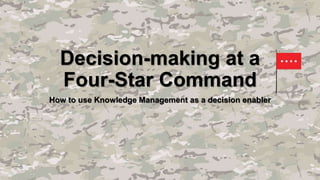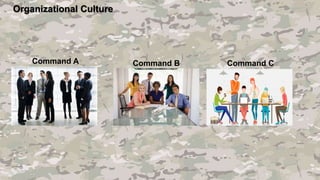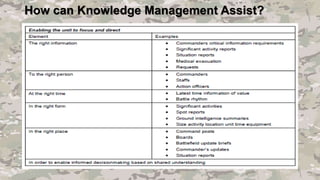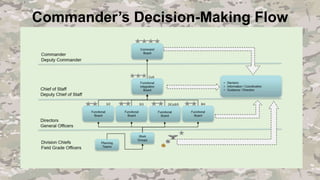Decision-making at a Four-Star Command
- 1. Decision-making at a Four-Star Command How to use Knowledge Management as a decision enabler
- 2. About the Presenter ŌĆó Retired after 21 years of military service (USMC & US Army) ŌĆó Veteran of Operation Iraqi Freedom, Operation New Dawn, Operation Inherent Resolve ŌĆó Stood up 7 Knowledge Management Offices within the Department of Defense ŌĆó Worked with militaries from over 70 nations ŌĆó Facilitated over 5,000 meetings at the General Officer level ŌĆó Knowledge Manager for four 4 Star Commands ŌĆó CEO of Knoco Austin & Cannon-Lear Enterprises
- 3. How does the DoD Define ŌĆó Knowledge Management (KM): is defined as a discipline focused on integrating people and processes enabled by tools throughout the information lifecycle in order to create shared understanding and increase organizational performance and decision-making. (Proposed DoDI 8220.AC) ŌĆó Military Decision-Making Process (MDMP): is an iterative planning methodology that integrates the activities of the commander, staff, subordinate headquarters, and other partners to understand the situation and mission, develop and compare courses of action (COAs), decide on a COA that best accomplishes the mission, and produce an operation plan or order for execution. (CALL 15-06)
- 4. Command A Command B Organizational Culture Command C
- 5. How does a General get their information? ŌĆó Briefings/Meetings ŌĆó On average a General spends between 8-12 hours a day in meetings ŌĆó Majority of the meetings are informative in nature this is to have the General situational awareness in the environment that they are responsible. ŌĆó ŌĆ£Read a headŌĆØ books ŌĆó These are typically hard copies of information papers, update briefing slides, etc. That inform the commander about various topics. ŌĆó Media ŌĆó Social Media ŌĆó News Channels/Articles/Papers etc. ŌĆó ŌĆ£Battlefield CirculationŌĆØ ŌĆó This is when the Commander goes outside of the headquarters to physically see what is going on with in their operational environment.
- 7. Situational Awareness Meetings Decision Meetings What is currently going on in the operating environment? What is the topics/issue that needs approved? What is the enemy going? Do I have the authority to make the decision? What are we doing? What do we have planned? What are the risks involved in making the decision? What are the Spheres of opportunities? What is the impact of the decision? Types of Meetings
- 8. How can Knowledge Management Assist?
- 9. Purpose: (State the purpose of the meeting. What questions is the meeting answering for the Commander? How does this meeting tie into the overall mission? This should be no more than three lines of text in this font) Frequency: Every X (Days/Weeks/Month/Quarterly, Annual) Chair: (By Office Symbol) Co-Chair: (By Office Symbol) Facilitator: (By Name, Section, email address) Secretariat: (By Name, Section, email address) Attendees: (Primaries, Deputies, Executive Officers, DIV Chiefs, AOŌĆÖs, Representatives) Required: (By Office Symbol) Optional: (By Office Symbol) Type of Meeting: (Command Board, Functional Board, Bureau, Center, Cell, Working Group, Planning Team, Situational Awareness Brief) Meeting Classification: (Classification of the content in the meeting) Agenda ŌĆó Item 1 ŌĆó Item 2 ŌĆó Item 3 ŌĆó Item 4 Products From Whom / Event Time/Method of Delivery Products To Whom / Event Time/Method of Delivery Inputs: Outputs: Condition Times (I) Physical Location Dial-In/Virtual Location Primary Alternate Contingency Emergency Name of Meeting
- 12. AFC Topic Flow Diagram FunctionalBoards (two+Directorates Chair) CommandBoard WorkingGroup (longterm/ enduring) PlanningTeams (Shortterm/ Projectbased) SeniorIntegration Board OPR: FCSG Senior Integration Board Command Board Functional Board Working Group Planning Team Planning Team Planning Team Planning Team Planning Team Planning Team Planning Team Planning Team Working Group Working Group Working Group Working Group Working Group Working Group Working Group Functional Board Functional Board Functional Board Functional Board Functional Board Ideal Hierarchical Decision-Making Flow (Single Command)
- 13. Four-Star Decision-Flow in Theater
Editor's Notes
- KM Challenge













